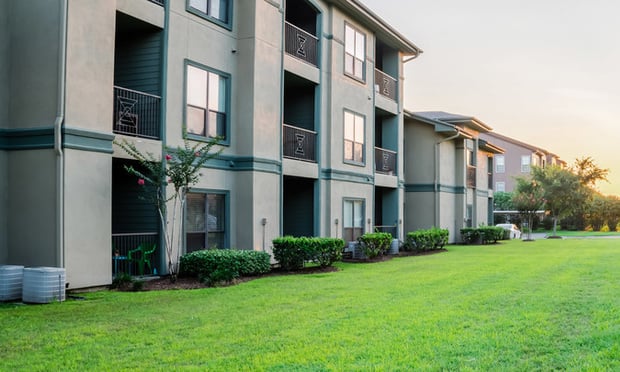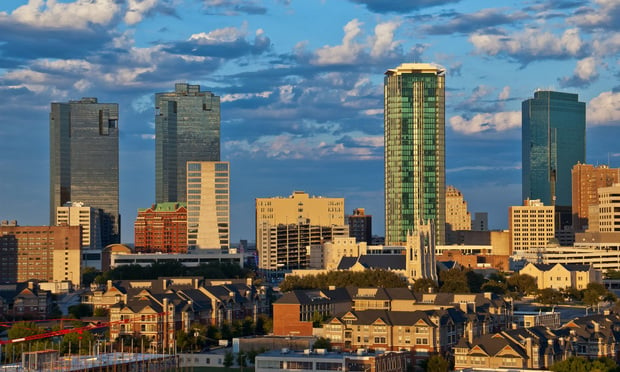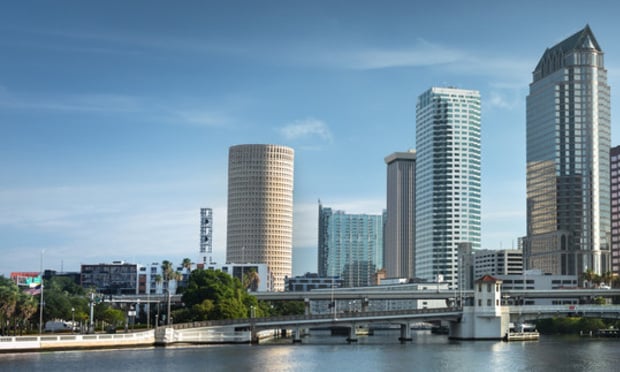 DALLAS—Dallas-Fort Worth remains one of the top apartment markets in the country with its robust employment environment. Average effective apartment rents in Dallas-Fort Worth increased for the seventh straight month in July, though the rate of those increases were slightly less than in June, according to Axiometrics . “DFW apartment performance remains among the strongest and steadiest in the nation,” said Jay Denton , senior vice president of analytics for Axiometrics. “Residents can expect rents to rise, and property owners and managers can expect the rate of return to not be as volatile as most other metros nationwide.” Overall, the average monthly rents increased from June to July in both the Dallas and Fort Worth metros. Effective rent in the Dallas metro was 5.1% higher in July 2016 than it was in July 2015, while rent growth was 5.9% in Fort Worth. July's occupancy rates were lower than June's in both Dallas and Fort Worth. Denton tells GlobeSt.com: "Despite increased levels of supply, DFW remains one of the top apartment markets in the country due to a robust job market. Effective rent growth remains north of 5% and occupancy rates continued to climb during the summer of 2016 as demand managed to outpace supply once again. Some locations in the market have been impacted by new supply. Areas near Uptown and Downtown Dallas are experiencing flat to negative rent growth as thousands of new units continue to deliver to the market, but the occupancy rates are holding strong at 95% for existing properties. There are a lot of success stories in DFW, but the brightest spots tend to be in class B and C properties, currently with rent growth close to 7%, and suburban neighborhoods. Average rent growth in Grand Prairie and Mesquite is close to 10%.” The average rent in Dallas-Plano-Irving is $1,134, with annual effective rent growth of 5.1% and occupancy hovering at the 95.5% mark. In Fort Worth-Arlington, TX, the average rent is $1,020, with annual effective rent growth of 5.9% and occupancy at a slightly higher rate of 95.7%. In comparison, the national average rent is $1,291, with annual effective rent growth of 3.1% and slightly lower occupancies of 95.1%. New supply is coming to the DFW area, most of it on the Dallas side of the metro. But job growth, among the highest in the nation, is more than enough to absorb these additional units. In June 2016, Dallas gained 99,600 jobs and Fort Worth had a gain of 14,500. “Supply and demand line up nicely for strong apartment-market performance in DFW,” Denton said. “Unless job growth slows significantly or there's a huge surge in supply, the market fundamentals look to remain strong.” Axiometrics is a provider of apartment and student housing market research and analysis. Steady gains in the US economy have resulted in net positives for the multifamily sector—will this wave continue for the foreseeable future? What's driving development and capital flows? Join us at RealShare Apartments on October 19 & 20 for impactful information from the leaders in the National multifamily space. Learn more.
DALLAS—Dallas-Fort Worth remains one of the top apartment markets in the country with its robust employment environment. Average effective apartment rents in Dallas-Fort Worth increased for the seventh straight month in July, though the rate of those increases were slightly less than in June, according to Axiometrics . “DFW apartment performance remains among the strongest and steadiest in the nation,” said Jay Denton , senior vice president of analytics for Axiometrics. “Residents can expect rents to rise, and property owners and managers can expect the rate of return to not be as volatile as most other metros nationwide.” Overall, the average monthly rents increased from June to July in both the Dallas and Fort Worth metros. Effective rent in the Dallas metro was 5.1% higher in July 2016 than it was in July 2015, while rent growth was 5.9% in Fort Worth. July's occupancy rates were lower than June's in both Dallas and Fort Worth. Denton tells GlobeSt.com: "Despite increased levels of supply, DFW remains one of the top apartment markets in the country due to a robust job market. Effective rent growth remains north of 5% and occupancy rates continued to climb during the summer of 2016 as demand managed to outpace supply once again. Some locations in the market have been impacted by new supply. Areas near Uptown and Downtown Dallas are experiencing flat to negative rent growth as thousands of new units continue to deliver to the market, but the occupancy rates are holding strong at 95% for existing properties. There are a lot of success stories in DFW, but the brightest spots tend to be in class B and C properties, currently with rent growth close to 7%, and suburban neighborhoods. Average rent growth in Grand Prairie and Mesquite is close to 10%.” The average rent in Dallas-Plano-Irving is $1,134, with annual effective rent growth of 5.1% and occupancy hovering at the 95.5% mark. In Fort Worth-Arlington, TX, the average rent is $1,020, with annual effective rent growth of 5.9% and occupancy at a slightly higher rate of 95.7%. In comparison, the national average rent is $1,291, with annual effective rent growth of 3.1% and slightly lower occupancies of 95.1%. New supply is coming to the DFW area, most of it on the Dallas side of the metro. But job growth, among the highest in the nation, is more than enough to absorb these additional units. In June 2016, Dallas gained 99,600 jobs and Fort Worth had a gain of 14,500. “Supply and demand line up nicely for strong apartment-market performance in DFW,” Denton said. “Unless job growth slows significantly or there's a huge surge in supply, the market fundamentals look to remain strong.” Axiometrics is a provider of apartment and student housing market research and analysis. Steady gains in the US economy have resulted in net positives for the multifamily sector—will this wave continue for the foreseeable future? What's driving development and capital flows? Join us at RealShare Apartments on October 19 & 20 for impactful information from the leaders in the National multifamily space. Learn more.  DALLAS—Dallas-Fort Worth remains one of the top apartment markets in the country with its robust employment environment. Average effective apartment rents in Dallas-Fort Worth increased for the seventh straight month in July, though the rate of those increases were slightly less than in June, according to Axiometrics . “DFW apartment performance remains among the strongest and steadiest in the nation,” said Jay Denton , senior vice president of analytics for Axiometrics. “Residents can expect rents to rise, and property owners and managers can expect the rate of return to not be as volatile as most other metros nationwide.” Overall, the average monthly rents increased from June to July in both the Dallas and Fort Worth metros. Effective rent in the Dallas metro was 5.1% higher in July 2016 than it was in July 2015, while rent growth was 5.9% in Fort Worth. July's occupancy rates were lower than June's in both Dallas and Fort Worth. Denton tells GlobeSt.com: "Despite increased levels of supply, DFW remains one of the top apartment markets in the country due to a robust job market. Effective rent growth remains north of 5% and occupancy rates continued to climb during the summer of 2016 as demand managed to outpace supply once again. Some locations in the market have been impacted by new supply. Areas near Uptown and Downtown Dallas are experiencing flat to negative rent growth as thousands of new units continue to deliver to the market, but the occupancy rates are holding strong at 95% for existing properties. There are a lot of success stories in DFW, but the brightest spots tend to be in class B and C properties, currently with rent growth close to 7%, and suburban neighborhoods. Average rent growth in Grand Prairie and Mesquite is close to 10%.” The average rent in Dallas-Plano-Irving is $1,134, with annual effective rent growth of 5.1% and occupancy hovering at the 95.5% mark. In Fort Worth-Arlington, TX, the average rent is $1,020, with annual effective rent growth of 5.9% and occupancy at a slightly higher rate of 95.7%. In comparison, the national average rent is $1,291, with annual effective rent growth of 3.1% and slightly lower occupancies of 95.1%. New supply is coming to the DFW area, most of it on the Dallas side of the metro. But job growth, among the highest in the nation, is more than enough to absorb these additional units. In June 2016, Dallas gained 99,600 jobs and Fort Worth had a gain of 14,500. “Supply and demand line up nicely for strong apartment-market performance in DFW,” Denton said. “Unless job growth slows significantly or there's a huge surge in supply, the market fundamentals look to remain strong.” Axiometrics is a provider of apartment and student housing market research and analysis. Steady gains in the US economy have resulted in net positives for the multifamily sector—will this wave continue for the foreseeable future? What's driving development and capital flows? Join us at RealShare Apartments on October 19 & 20 for impactful information from the leaders in the National multifamily space. Learn more.
DALLAS—Dallas-Fort Worth remains one of the top apartment markets in the country with its robust employment environment. Average effective apartment rents in Dallas-Fort Worth increased for the seventh straight month in July, though the rate of those increases were slightly less than in June, according to Axiometrics . “DFW apartment performance remains among the strongest and steadiest in the nation,” said Jay Denton , senior vice president of analytics for Axiometrics. “Residents can expect rents to rise, and property owners and managers can expect the rate of return to not be as volatile as most other metros nationwide.” Overall, the average monthly rents increased from June to July in both the Dallas and Fort Worth metros. Effective rent in the Dallas metro was 5.1% higher in July 2016 than it was in July 2015, while rent growth was 5.9% in Fort Worth. July's occupancy rates were lower than June's in both Dallas and Fort Worth. Denton tells GlobeSt.com: "Despite increased levels of supply, DFW remains one of the top apartment markets in the country due to a robust job market. Effective rent growth remains north of 5% and occupancy rates continued to climb during the summer of 2016 as demand managed to outpace supply once again. Some locations in the market have been impacted by new supply. Areas near Uptown and Downtown Dallas are experiencing flat to negative rent growth as thousands of new units continue to deliver to the market, but the occupancy rates are holding strong at 95% for existing properties. There are a lot of success stories in DFW, but the brightest spots tend to be in class B and C properties, currently with rent growth close to 7%, and suburban neighborhoods. Average rent growth in Grand Prairie and Mesquite is close to 10%.” The average rent in Dallas-Plano-Irving is $1,134, with annual effective rent growth of 5.1% and occupancy hovering at the 95.5% mark. In Fort Worth-Arlington, TX, the average rent is $1,020, with annual effective rent growth of 5.9% and occupancy at a slightly higher rate of 95.7%. In comparison, the national average rent is $1,291, with annual effective rent growth of 3.1% and slightly lower occupancies of 95.1%. New supply is coming to the DFW area, most of it on the Dallas side of the metro. But job growth, among the highest in the nation, is more than enough to absorb these additional units. In June 2016, Dallas gained 99,600 jobs and Fort Worth had a gain of 14,500. “Supply and demand line up nicely for strong apartment-market performance in DFW,” Denton said. “Unless job growth slows significantly or there's a huge surge in supply, the market fundamentals look to remain strong.” Axiometrics is a provider of apartment and student housing market research and analysis. Steady gains in the US economy have resulted in net positives for the multifamily sector—will this wave continue for the foreseeable future? What's driving development and capital flows? Join us at RealShare Apartments on October 19 & 20 for impactful information from the leaders in the National multifamily space. Learn more.
Want to continue reading?
Become a Free ALM Digital Reader.
Once you are an ALM Digital Member, you’ll receive:
- Breaking commercial real estate news and analysis, on-site and via our newsletters and custom alerts
- Educational webcasts, white papers, and ebooks from industry thought leaders
- Critical coverage of the property casualty insurance and financial advisory markets on our other ALM sites, PropertyCasualty360 and ThinkAdvisor
Already have an account? Sign In Now
*May exclude premium content© 2024 ALM Global, LLC, All Rights Reserved. Request academic re-use from www.copyright.com. All other uses, submit a request to [email protected]. For more information visit Asset & Logo Licensing.








